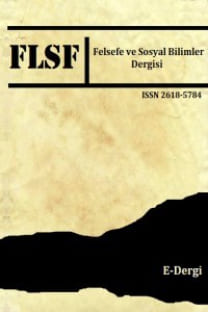FELSEFE VE SANAT ARASINDA: ESTETİK DÜŞÜNÜM
Sanat, Felsefe, Estetik, Sanat Felsefesi, Estetik Düşünüm.
BETWEEN PHILOSOPHY AND ART: AESTHETIC REFLECTION
Art, Philosophy, Aesthetics, Philosophy of Art. Aesthetic Reflection.,
___
- Adorno, T. W. (2014). Negatif Diyalektik, Şeyda Öztürk(çev.), Metis Yayınları, İstanbul.
- Adorno, T. W. (2002). Aesthetic Theory, Robert Hullot-Kentor (trans.), Continuum, London.
- Altuğ, T. (2012). Son Bakışta Sanat. Yapı Kredi Yayınları, İstanbul.
- Badiou, A. (2010). Başka Bir Estetik. Aziz Ufuk Kılıç (çev.), Metis Yayınları,İstanbul.
- Bergson, H. (2010). The Creative Mind: An Introduction to Metaphysics, Andison, Mabelle L. (trans) Dover Publication Inc, New York
- Bernstein, Jay M. (1992). The Fate of Art: Aesthetic Alienation from Kant to Derrida and Adorno. Penn State Press, Pennsylvania.
- Deleuze, G. (2006). Müzakereler, İnci uysal (çev.)., Norgunk Yayıncılık, İstanbul
- Deleuze, G. (2017). Fark ve Tekrar. Burcu Yalım & Emre Koyuncu (çev.), Norgunk Yayıncılık, İstanbul.
- Deleuze,G. & Guattari, F. (1994). What Is Philosophy?, HughTomlinson and Graham Burchell (trans.) Columbia University Press, New York.
- Gombrich, E. H. (1992). Sanatın Öyküsü. Bedrettin Cömert(çev.), Remzi Kitabevi, İstanbul.
- Hegel, G. W. F. (1994). Estetik: Güzel Sanatlar Üzerine Dersler Cilt I. Taylan Altuğ, and Hakkı Hünler (çev.). Payel yayınları, İstanbul.
- Kant, I. (2007). The Critique of Judgement. J.C.Meredith (trans.), Oxford University Press, New York.
- Kuspit, D. B., (2006).Sanatın sonu. Yasemin Tezgiden (çev.) Metis, İstanbul.
- Lorand, R. (2002). Aesthetic Order: A Philosophy of Order, Beauty and Art. Routledge. New York.
- Shusterman, R. & Tomlin, A. (Eds.) (2008). Aesthetic Experience. Routledge. New York.
- Shaviro, S. (2012). Without Criteria: Kant, Whitehead, Deleuze, and Aesthetics. MIT Press, Cambridge.
- Schelling, F.W.J. (2017). Sanat Felsefesi, Merve Ertene&Serhat Arslan (çev.), Doğu Batı yayınları, Ankara.
- Yayın Aralığı: Yılda 2 Sayı
- Başlangıç: 2006
- Yayıncı: Hamdi BRAVO
NIETZSCHE’NİN ONTOLOJİK VE ETİK-POLİTİK OKUMALARI: HEIDEGGER’E KARŞI DELEUZE
LEO STRAUSS’UN HIERO YORUMUNDA TİRANLIK ÖĞRETİSİ VE FELSEFE
NIETZSCHE VE TRANSHÜMANİZM BAĞLANTISI ÜZERİNE BİR DEĞERLENDİRME
SİYASET FELSEFESİ PERSPEKTİFİNDEN DEMOKRASİ VE ANA AKIM İLİŞKİSİ: ÇELİŞKİ Mİ, TUTARLILIK MI?
EDWARD SAID’İN METODOLOJİSİNDE SÖYLEM-İDEOLOJİ İLİŞKİSİ
MODERN FELSEFENİN YENİ BİR KATEGORİSİ OLARAK; KİERKEGAARD’IN YİNELEME KAVRAMI
SİNİZM ÇAĞINDA ARZUNUN KUVVETİ: İDEOLOJİNİN ÖTESİNDE POLİTİKAYI YENİDEN DÜŞÜNMEK
BAKIM/ÖZEN ETİĞİ VE ULUSLARARASI SİYASETİN BAZI NORMATİF SORULARI İÇİN ÖNEMİ
